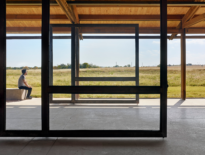Introducing ILFI’s New Zero Carbon Certification
ILFI is excited to announce its new Zero Carbon Certification. Providing a new performance pathway situated between Reveal and the Zero Energy Certification, the Zero Carbon Certification provides greater flexibility around project fuel types (for existing projects) and placement and ownership of offsetting renewables.
The ILFI Zero Carbon Certification is the first worldwide Zero Carbon third-party certified standard. It recognizes the growing interest and focus on a broad-based tool for highlighting highly efficient buildings which offset their energy use, regardless of location of renewables, as well as accommodating previously built combustion based infrastructure. It also recognizes increasing corporate efforts to create meaningful carbon offsetting systems which result in real, positive change. It builds on and implements the Zero Carbon concept released by Architecture 2030, the Rocky Mountain Institute, and the New Buildings Institute in 2016, and the worldwide call for zero carbon standards from the World Green Building Council issued in 2017.
Summary of Zero Carbon Certification requirements
During a one-year performance period, buildings must achieve a targeted energy efficiency level. Existing projects may use any type of energy, including those that are combustion based, but new projects may not include combustion. One hundred percent of the project’s energy use must be offset by on- or off-site renewable energy on a net annual basis. The project must provide offsetting renewables which have the equivalent of 15 years of project power, provide additionality, and have durable ownership integrity associated with the project. The complete requirements can be seen here.
How does Zero Carbon relate to Living Buildings, the Energy Petal, Zero Energy, and Reveal?
In the hierarchy of quality and sustainability, the Zero Carbon certification is the first step towards Living Building Challenge certification. It represents a significant improvement over the norm, and fills in a gap between Zero Energy Certification and the energy performance of code-based buildings or less stringent green building certifications. The following chart shows the hierarchy and associated attributes of ILFI’s Energy certification levels:
Features
- Has worldwide applicability; can be used broadly by projects, corporations, districts, and jurisdictions seeking to substantially raise the bar on efficiency, and create a renewably powered electrical grid.
- Useful for existing buildings which have combustion embedded within their existing mechanical systems, and where there may be constraints on higher levels of efficiency improvements, where a full renovation is infeasible.
- Provides a broad range of efficiency targets, including where zero carbon levels have been locally established.
Visit the Zero Carbon webpage to learn more about our newest certification!




